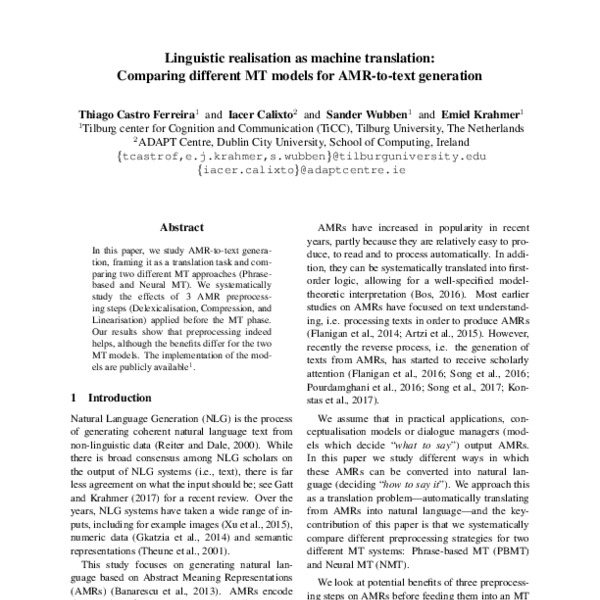 If system and consumer objectives align, then a system that higher meets its targets could make users happier and customers could also be extra keen to cooperate with the system (e.g., react to prompts). Typically, with extra funding into measurement we are able to enhance our measures, which reduces uncertainty in choices, which permits us to make higher decisions. Descriptions of measures will not often be good and ambiguity free, but better descriptions are extra precise. Beyond aim setting, we'll particularly see the necessity to become inventive with creating measures when evaluating fashions in manufacturing, as we will discuss in chapter Quality Assurance in Production. Better models hopefully make our customers happier or contribute in varied ways to making the system obtain its objectives. The approach additionally encourages to make stakeholders and context elements express. The important thing benefit of such a structured approach is that it avoids advert-hoc measures and a deal with what is easy to quantify, however instead focuses on a prime-down design that begins with a clear definition of the objective of the measure after which maintains a transparent mapping of how specific measurement activities collect information that are actually significant toward that purpose. Unlike previous versions of the mannequin that required pre-coaching on large amounts of data, GPT Zero takes a singular approach.
If system and consumer objectives align, then a system that higher meets its targets could make users happier and customers could also be extra keen to cooperate with the system (e.g., react to prompts). Typically, with extra funding into measurement we are able to enhance our measures, which reduces uncertainty in choices, which permits us to make higher decisions. Descriptions of measures will not often be good and ambiguity free, but better descriptions are extra precise. Beyond aim setting, we'll particularly see the necessity to become inventive with creating measures when evaluating fashions in manufacturing, as we will discuss in chapter Quality Assurance in Production. Better models hopefully make our customers happier or contribute in varied ways to making the system obtain its objectives. The approach additionally encourages to make stakeholders and context elements express. The important thing benefit of such a structured approach is that it avoids advert-hoc measures and a deal with what is easy to quantify, however instead focuses on a prime-down design that begins with a clear definition of the objective of the measure after which maintains a transparent mapping of how specific measurement activities collect information that are actually significant toward that purpose. Unlike previous versions of the mannequin that required pre-coaching on large amounts of data, GPT Zero takes a singular approach.
 It leverages a transformer-based Large Language Model (LLM) to provide textual content that follows the users instructions. Users accomplish that by holding a pure language dialogue with UC. In the chatbot instance, this potential battle is much more obvious: More advanced natural language capabilities and legal data of the model may lead to extra authorized questions that may be answered with out involving a lawyer, making purchasers searching for legal recommendation happy, however doubtlessly decreasing the lawyer’s satisfaction with the chatbot as fewer shoppers contract their companies. On the other hand, shoppers asking legal questions are users of the system too who hope to get legal advice. For example, when deciding which candidate to rent to develop the chatbot technology, we will depend on simple to collect data comparable to college grades or an inventory of past jobs, but we may invest extra effort by asking consultants to evaluate examples of their previous work or asking candidates to unravel some nontrivial sample tasks, possibly over extended remark periods, or even hiring them for an extended attempt-out period. In some cases, knowledge collection and operationalization are simple, as a result of it is apparent from the measure what information must be collected and how the information is interpreted - for example, measuring the number of attorneys at the moment licensing our software can be answered with a lookup from our license database and to measure check high quality by way of branch coverage commonplace tools like Jacoco exist and may even be talked about in the outline of the measure itself.
It leverages a transformer-based Large Language Model (LLM) to provide textual content that follows the users instructions. Users accomplish that by holding a pure language dialogue with UC. In the chatbot instance, this potential battle is much more obvious: More advanced natural language capabilities and legal data of the model may lead to extra authorized questions that may be answered with out involving a lawyer, making purchasers searching for legal recommendation happy, however doubtlessly decreasing the lawyer’s satisfaction with the chatbot as fewer shoppers contract their companies. On the other hand, shoppers asking legal questions are users of the system too who hope to get legal advice. For example, when deciding which candidate to rent to develop the chatbot technology, we will depend on simple to collect data comparable to college grades or an inventory of past jobs, but we may invest extra effort by asking consultants to evaluate examples of their previous work or asking candidates to unravel some nontrivial sample tasks, possibly over extended remark periods, or even hiring them for an extended attempt-out period. In some cases, knowledge collection and operationalization are simple, as a result of it is apparent from the measure what information must be collected and how the information is interpreted - for example, measuring the number of attorneys at the moment licensing our software can be answered with a lookup from our license database and to measure check high quality by way of branch coverage commonplace tools like Jacoco exist and may even be talked about in the outline of the measure itself.
For instance, making higher hiring decisions can have substantial benefits, hence we would make investments more in evaluating candidates than we would measuring restaurant high quality when deciding on a place for dinner tonight. That is vital for purpose setting and particularly for speaking assumptions and ensures across teams, corresponding to communicating the standard of a mannequin to the crew that integrates the mannequin into the product. The computer "sees" all the soccer area with a video digicam and identifies its personal team members, its opponent's members, the ball and the objective based on their coloration. Throughout the whole improvement lifecycle, we routinely use lots of measures. User targets: Users typically use a software program system with a particular goal. For example, there are a number of notations for purpose modeling, to describe targets (at completely different levels and of different importance) and their relationships (numerous types of support and conflict and alternatives), and there are formal processes of purpose refinement that explicitly relate targets to each other, down to superb-grained requirements.
Model objectives: From the perspective of a machine-learned model, the purpose is sort of always to optimize the accuracy of predictions. Instead of "measure accuracy" specify "measure accuracy with MAPE," which refers to a effectively defined present measure (see also chapter Model high quality: Measuring prediction accuracy). For instance, the accuracy of our measured AI-powered chatbot subscriptions is evaluated in terms of how closely it represents the actual number of subscriptions and the accuracy of a person-satisfaction measure is evaluated in terms of how properly the measured values represents the precise satisfaction of our users. For example, when deciding which project to fund, we'd measure each project’s threat and potential; when deciding when to stop testing, we'd measure how many bugs we've got found or how much code we now have coated already; when deciding which mannequin is best, we measure prediction accuracy on take a look at knowledge or in manufacturing. It's unlikely that a 5 p.c enchancment in model accuracy translates straight into a 5 percent improvement in person satisfaction and a 5 p.c enchancment in income.
If you have any queries regarding where by and how to use
language understanding AI, you can get hold of us at our web page.